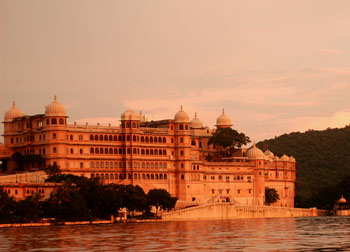 The Aravali range, weathered and humbled by time, plundered and ravaged by mindless mining are among the oldest hills on planet Earth. Pichola Lake, shimmering in its fullness, reflects the fabled palaces, a tribute to Rajput history. The monsoon skies are a many-splendoured panorama of changing moods. There are many lakes in the area, both with and without name, famed and hidden. Jaisamand Lake, 50 kms from here, is Asia's second largest man-made lake, with an area of 36 sq kms. Fateh Sagar Lake, originally created in 1678 AD, was later extended. Almost dry in the 90s, for the past 6 years it has remained filled. On 4th Sept 2011, it overflowed to the delight of the local population, who gathered in large numbers to witness the event.
The Aravali range, weathered and humbled by time, plundered and ravaged by mindless mining are among the oldest hills on planet Earth. Pichola Lake, shimmering in its fullness, reflects the fabled palaces, a tribute to Rajput history. The monsoon skies are a many-splendoured panorama of changing moods. There are many lakes in the area, both with and without name, famed and hidden. Jaisamand Lake, 50 kms from here, is Asia's second largest man-made lake, with an area of 36 sq kms. Fateh Sagar Lake, originally created in 1678 AD, was later extended. Almost dry in the 90s, for the past 6 years it has remained filled. On 4th Sept 2011, it overflowed to the delight of the local population, who gathered in large numbers to witness the event.
The City Palace Complex on the banks of Lake Pichola houses several palaces, including the museum that encapsulates Mewar's royal dynasty. It is the residence of the descendants of the Suryavanshi Rajput rulers of Mewar. Two of the palaces here, Fateh Prakash Palace and Shiv Niwas Palace have been converted into heritage hotels.
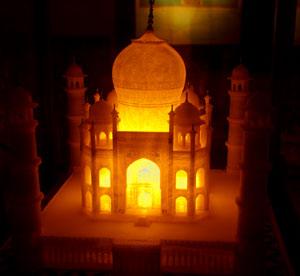 Construction of Jag Mandir, the palace on an island in Lake Pichola, began in 1551. Known for its pleasure gardens, Maharana Karan Singh gave refuge to Prince Khurram, whose mother was a Rajput princess. Later crowned Shah Jahan, he lived here along with his wife Mumtaz Mahal and his two sons, Prince Dara and Prince Aurangzeb under the protection of the Mewar kingdom. It is said that Shah Jahan's memories of the palace here inspired parts of the creation of the Taj Mahal at Agra. He sent a replica of the Taj Mahal which is housed here.
Construction of Jag Mandir, the palace on an island in Lake Pichola, began in 1551. Known for its pleasure gardens, Maharana Karan Singh gave refuge to Prince Khurram, whose mother was a Rajput princess. Later crowned Shah Jahan, he lived here along with his wife Mumtaz Mahal and his two sons, Prince Dara and Prince Aurangzeb under the protection of the Mewar kingdom. It is said that Shah Jahan's memories of the palace here inspired parts of the creation of the Taj Mahal at Agra. He sent a replica of the Taj Mahal which is housed here.
Sajjan Garh Palace, the summer resort of the Mewar kingdom, also called monsoon palace, has a grand overview of the lakes, palaces, the city of Udaipur and beyond.
Saheliyon ki Bari was created in the 18th century for the royal pastimes of the ladies-in waiting, and is reminiscent of a time when royal gardens were an artistic creation, both luxuriant and delightful.
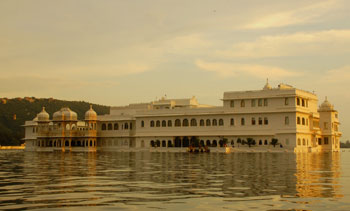 Like all tourists, I had once stood at the edge of Pichola Lake and gazed from afar at the Lake Palace, standing in all its pristine glory in the midst of the lake. The marble here is not cold, aloof, colourless, but a glistening pure translucent white. History here is alive. That is the very charm and romance of Rajasthan, that the past is ever-present. Arriving here, with the traditional welcome of a shower of rose petals, and escorted to the palace with a chatri, greeted by the personal butler assigned to ensure that nothing is left to chance, the stay here was as pleasurable as it was indulgent. Each suite whispers a different tale. Sitting in Jharoka, the 24 hour diner, time no longer moves lineally. Overlooking the waters of the lake, with cuisine from different parts of the world, this is fine dining in royal tradition. Watching the sunrise from the secluded private terrace adjoining our suite, peeping unseen over the balustrade to watch the evening's entertainment of Rajasthani folk songs and dance,
Like all tourists, I had once stood at the edge of Pichola Lake and gazed from afar at the Lake Palace, standing in all its pristine glory in the midst of the lake. The marble here is not cold, aloof, colourless, but a glistening pure translucent white. History here is alive. That is the very charm and romance of Rajasthan, that the past is ever-present. Arriving here, with the traditional welcome of a shower of rose petals, and escorted to the palace with a chatri, greeted by the personal butler assigned to ensure that nothing is left to chance, the stay here was as pleasurable as it was indulgent. Each suite whispers a different tale. Sitting in Jharoka, the 24 hour diner, time no longer moves lineally. Overlooking the waters of the lake, with cuisine from different parts of the world, this is fine dining in royal tradition. Watching the sunrise from the secluded private terrace adjoining our suite, peeping unseen over the balustrade to watch the evening's entertainment of Rajasthani folk songs and dance,
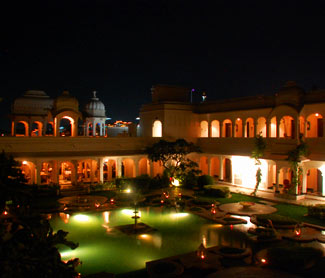 talking to the resident astrologer on Mewar terrace as the sun sets, sampling the delicacies of the region at Neelkamal, I realise that what Taj does best is to make you feel at home, wherever you are, whoever you are.
talking to the resident astrologer on Mewar terrace as the sun sets, sampling the delicacies of the region at Neelkamal, I realise that what Taj does best is to make you feel at home, wherever you are, whoever you are.
With its legacy of warm and elegant hospitality, Taj Hotels was the obvious choice to continue the tradition at the Lake Palace and host those who were fated to enjoy the hospitality of this Mewar palace in its current ethos.
And yet, the truth is that the simplest homes in Mewar are as gracious and generous in their hospitality as are the grandest of its palaces. I have travelled through the villages of Mewar, staying in remote villages for several days, visiting the tapasya sthals and temples in Mewar. I realise that my connection with Rajasthan is timeless, because I am as comfortable in its villages, and hidden places of worship, as I am in its havelis and palaces.
What possibly compels me most to Mewar is that the rulers of Mewar have always called themselves Maharana, because the title of Maharaja of Mewar belongs to Eklingji Mahadeva. So in Mewar, I first go to pay tribute at the complex of 108 temples, where the deity of Mewar rules supreme, unfazed by the politics of change. And at the royal palace here, with court musicians playing, Lord Shiva is bedecked in jewels according to the day of the week - if it is Monday it must be diamonds, Tuesday rubies... blue sapphire, yellow sapphire, pearls. I am accustomed to the sky-clad Shiva-ji, besmeared with the ashes of cremation grounds. I am always touched by the way the people of Mewar come here for darshan of their Maharaja, with unconcealed excitement and a sense of anticipation, very different from other temples of Bhagwan Shankar, where they go, often with tired shuffling feet, to worship him. And I come here to catch a glimpse at this other face of Lord Shiva that he favours his subjects at Mewar with.
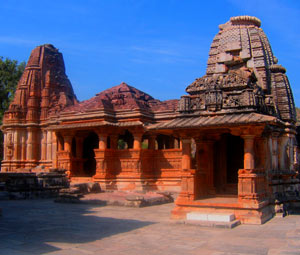 The temple here was built in the 8th century by Bappa Rawal, founder of the Mewar kingdom, who is believed to have been blessed by Rishi Harit. Like most ancient Shiva temples, legend and worship pre-dates historical time. It is said that in the Sat Yuga, Lord Indra did tapasya here to appease Lord Shiva. The nearby Indra Sarovar bears testimony to this. During the Treta Yuga, Kamdhenu Nandini sought protection of Eklingj from Rishi Vishwamitra. In Dwapar Yuga, when Janamejaya, son of Raja Parikshit, performed the sacrifice of snakes, Takshaka Naga sought protection here. The Takshaka Kund is a reminder of this.
The temple here was built in the 8th century by Bappa Rawal, founder of the Mewar kingdom, who is believed to have been blessed by Rishi Harit. Like most ancient Shiva temples, legend and worship pre-dates historical time. It is said that in the Sat Yuga, Lord Indra did tapasya here to appease Lord Shiva. The nearby Indra Sarovar bears testimony to this. During the Treta Yuga, Kamdhenu Nandini sought protection of Eklingj from Rishi Vishwamitra. In Dwapar Yuga, when Janamejaya, son of Raja Parikshit, performed the sacrifice of snakes, Takshaka Naga sought protection here. The Takshaka Kund is a reminder of this.
Here, as in all Shiva temples in the region, Mahadeva is worshipped as the five-faced Eklingji, In the west is Brahma, north is Vishnu, east is Surya and south is Rudra. At the center, as its fifth face, is the Shivalinga.
There are many temples in Rajasthan, each bears testimony to the history of the land. A km away, barely visited by tourists, is the Saas-Bahu temple, a marvel in temple architecture. If our history is seen through our temples, it would be easy to understand the underlying continuity and inspiration that has guided our people and culture.
 Nathdwara, just over 20 kms away, is famous for its temple of Lord Krishna which houses the idol of Shrinathji, a 14th century, child incarnation of Krishna, originally worshipped at Mathura, shifted in 1672, to protect it from Mughal emperor Aurangzeb.
Nathdwara, just over 20 kms away, is famous for its temple of Lord Krishna which houses the idol of Shrinathji, a 14th century, child incarnation of Krishna, originally worshipped at Mathura, shifted in 1672, to protect it from Mughal emperor Aurangzeb.
The fortresses of Mewar are a truly awesome tribute to architecture. Kumbhalgarh is a 15th-century fortress, built by Rana Kumbha of Mewar. It captures the history and tradition of the Suryavanshi Rajputs, regal in bearing, noble in tradition and value, courageous and valiant, committed and loyal.
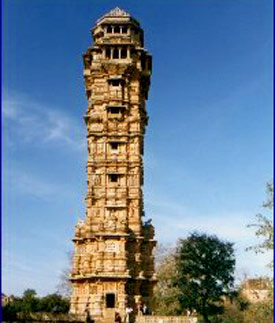 The Chittorgarh fort is believed to have been built by the Maurya rulers in 7th century A.D. Bappa Rawal is thought to have received it as dowry, and had made Chittor his capital. Later, in 1303 AD, it was attacked by Alauddin Khilji who was enamoured by tales of the beauty of Rani Padmini , who committed jauhar along with other ladies of the court, rather than surrender to the enemy. Recaptured in 1326 by the young Hammir Singh, Chittorgarh was plundered again in 1535 by Sultan Bahadur Shah of Gujrat. It is said that history repeated itself. All 32,000 men then living in the fort donned saffron robes of martyrdom and rode to their valiant death, while the Rajput women, inspired by Rani Karnawati, committed jauhar, The final siege of Chittorgarh was in 1567, by the Moghul Emperor Akbar, in his attempt to subdue Maharana Udai Singh. At the fort at Chittorgarh the ancient temple dedicated to Goddess Kali bears witness to the chequered history here.
The Chittorgarh fort is believed to have been built by the Maurya rulers in 7th century A.D. Bappa Rawal is thought to have received it as dowry, and had made Chittor his capital. Later, in 1303 AD, it was attacked by Alauddin Khilji who was enamoured by tales of the beauty of Rani Padmini , who committed jauhar along with other ladies of the court, rather than surrender to the enemy. Recaptured in 1326 by the young Hammir Singh, Chittorgarh was plundered again in 1535 by Sultan Bahadur Shah of Gujrat. It is said that history repeated itself. All 32,000 men then living in the fort donned saffron robes of martyrdom and rode to their valiant death, while the Rajput women, inspired by Rani Karnawati, committed jauhar, The final siege of Chittorgarh was in 1567, by the Moghul Emperor Akbar, in his attempt to subdue Maharana Udai Singh. At the fort at Chittorgarh the ancient temple dedicated to Goddess Kali bears witness to the chequered history here.
The art and architecture of Mewar is just one more expression of the multi-faceted character and personality of the Rajputs. Their art is a celebration of their living traditions which have survived the ravages of time. Mewar's rulers were patrons of all that was best in Indian martial and fine arts, architecture, and learning.
 Many names are written in gold, whose lives will continue to inspire. Maharana Pratap, the personification of Rajput values, took an oath to spend his life in tapasya, to re-conquer Chittorgarh from Akbar and regain the glory of Mewar. He underwent untold hardships, ruling from hidden caves and hiding in ravines, perpetually engaged in warfare. He is arguably the most honoured among the honourable Rajputs of Mewar for standing resolute in the face of bitter battles, in the darkest era of Rajput history, upholding the valour, dignity and cherished values of his clan. He died in 1597 held in the highest esteem, by friend and foe, alike.
Many names are written in gold, whose lives will continue to inspire. Maharana Pratap, the personification of Rajput values, took an oath to spend his life in tapasya, to re-conquer Chittorgarh from Akbar and regain the glory of Mewar. He underwent untold hardships, ruling from hidden caves and hiding in ravines, perpetually engaged in warfare. He is arguably the most honoured among the honourable Rajputs of Mewar for standing resolute in the face of bitter battles, in the darkest era of Rajput history, upholding the valour, dignity and cherished values of his clan. He died in 1597 held in the highest esteem, by friend and foe, alike.
I can see hundreds of years of the history of Rajasthan as though I have witnessed it: been bereft at the death of Maharana Pratap's horse, Chetak; grieved inconsolably at the bloodshed at Haldighati; been humbled by the tradition of honour and glory at Chittorgarh. I know the integrity and the valour of the Rajputs, I know their hardships, I know their lands, I know their customs, I know the generosity of their spirit. I can cry with them and rejoice with them. I doubt whether any other state can boast of women so courageous, while upholding traditions, so strong and fearless behind the traditional ghunghat. And nowhere are the men so emotional and expressive. And yet, the women are so feminine and graceful and the men so valiant and chivalrous. It is these very contradictions that remind us that Mewar is truly unique. The fact that paradoxes co-exist is itself a celebration of life.
Photo Credit: Siddhartha Butalia
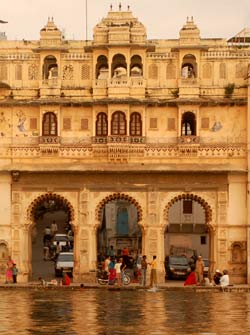 Can epithets like City of Lakes, The White City, City of Palaces, City of Dawn do justice to Udaipur? In 1568, Maharana Udai Singh established the seat of government here, having shifted the capital of the kingdom of Mewar from beleaguered Chittor. Udaipur, where royal traditions are part of the lifestyle, is seductive in its beauty, elegance and grace. Udaipur will always conjure a myriad images that will compel one to remember. Was I there last week, or was it a dream I did not want to wake from?
Can epithets like City of Lakes, The White City, City of Palaces, City of Dawn do justice to Udaipur? In 1568, Maharana Udai Singh established the seat of government here, having shifted the capital of the kingdom of Mewar from beleaguered Chittor. Udaipur, where royal traditions are part of the lifestyle, is seductive in its beauty, elegance and grace. Udaipur will always conjure a myriad images that will compel one to remember. Was I there last week, or was it a dream I did not want to wake from?
 The Aravali range, weathered and humbled by time, plundered and ravaged by mindless mining are among the oldest hills on planet Earth. Pichola Lake, shimmering in its fullness, reflects the fabled palaces, a tribute to Rajput history. The monsoon skies are a many-splendoured panorama of changing moods. There are many lakes in the area, both with and without name, famed and hidden. Jaisamand Lake, 50 kms from here, is Asia's second largest man-made lake, with an area of 36 sq kms. Fateh Sagar Lake, originally created in 1678 AD, was later extended. Almost dry in the 90s, for the past 6 years it has remained filled. On 4th Sept 2011, it overflowed to the delight of the local population, who gathered in large numbers to witness the event.
The Aravali range, weathered and humbled by time, plundered and ravaged by mindless mining are among the oldest hills on planet Earth. Pichola Lake, shimmering in its fullness, reflects the fabled palaces, a tribute to Rajput history. The monsoon skies are a many-splendoured panorama of changing moods. There are many lakes in the area, both with and without name, famed and hidden. Jaisamand Lake, 50 kms from here, is Asia's second largest man-made lake, with an area of 36 sq kms. Fateh Sagar Lake, originally created in 1678 AD, was later extended. Almost dry in the 90s, for the past 6 years it has remained filled. On 4th Sept 2011, it overflowed to the delight of the local population, who gathered in large numbers to witness the event.
 Construction of Jag Mandir, the palace on an island in Lake Pichola, began in 1551. Known for its pleasure gardens, Maharana Karan Singh gave refuge to Prince Khurram, whose mother was a Rajput princess. Later crowned Shah Jahan, he lived here along with his wife Mumtaz Mahal and his two sons, Prince Dara and Prince Aurangzeb under the protection of the Mewar kingdom. It is said that Shah Jahan's memories of the palace here inspired parts of the creation of the Taj Mahal at Agra. He sent a replica of the Taj Mahal which is housed here.
Construction of Jag Mandir, the palace on an island in Lake Pichola, began in 1551. Known for its pleasure gardens, Maharana Karan Singh gave refuge to Prince Khurram, whose mother was a Rajput princess. Later crowned Shah Jahan, he lived here along with his wife Mumtaz Mahal and his two sons, Prince Dara and Prince Aurangzeb under the protection of the Mewar kingdom. It is said that Shah Jahan's memories of the palace here inspired parts of the creation of the Taj Mahal at Agra. He sent a replica of the Taj Mahal which is housed here. Like all tourists, I had once stood at the edge of Pichola Lake and gazed from afar at the Lake Palace, standing in all its pristine glory in the midst of the lake. The marble here is not cold, aloof, colourless, but a glistening pure translucent white. History here is alive. That is the very charm and romance of Rajasthan, that the past is ever-present. Arriving here, with the traditional welcome of a shower of rose petals, and escorted to the palace with a chatri, greeted by the personal butler assigned to ensure that nothing is left to chance, the stay here was as pleasurable as it was indulgent. Each suite whispers a different tale. Sitting in Jharoka, the 24 hour diner, time no longer moves lineally. Overlooking the waters of the lake, with cuisine from different parts of the world, this is fine dining in royal tradition. Watching the sunrise from the secluded private terrace adjoining our suite, peeping unseen over the balustrade to watch the evening's entertainment of Rajasthani folk songs and dance,
Like all tourists, I had once stood at the edge of Pichola Lake and gazed from afar at the Lake Palace, standing in all its pristine glory in the midst of the lake. The marble here is not cold, aloof, colourless, but a glistening pure translucent white. History here is alive. That is the very charm and romance of Rajasthan, that the past is ever-present. Arriving here, with the traditional welcome of a shower of rose petals, and escorted to the palace with a chatri, greeted by the personal butler assigned to ensure that nothing is left to chance, the stay here was as pleasurable as it was indulgent. Each suite whispers a different tale. Sitting in Jharoka, the 24 hour diner, time no longer moves lineally. Overlooking the waters of the lake, with cuisine from different parts of the world, this is fine dining in royal tradition. Watching the sunrise from the secluded private terrace adjoining our suite, peeping unseen over the balustrade to watch the evening's entertainment of Rajasthani folk songs and dance,
 talking to the resident astrologer on Mewar terrace as the sun sets, sampling the delicacies of the region at Neelkamal, I realise that what Taj does best is to make you feel at home, wherever you are, whoever you are.
talking to the resident astrologer on Mewar terrace as the sun sets, sampling the delicacies of the region at Neelkamal, I realise that what Taj does best is to make you feel at home, wherever you are, whoever you are.
 The temple here was built in the 8th century by Bappa Rawal, founder of the Mewar kingdom, who is believed to have been blessed by Rishi Harit. Like most ancient Shiva temples, legend and worship pre-dates historical time. It is said that in the Sat Yuga, Lord Indra did tapasya here to appease Lord Shiva. The nearby Indra Sarovar bears testimony to this. During the Treta Yuga, Kamdhenu Nandini sought protection of Eklingj from Rishi Vishwamitra. In Dwapar Yuga, when Janamejaya, son of Raja Parikshit, performed the sacrifice of snakes, Takshaka Naga sought protection here. The Takshaka Kund is a reminder of this.
The temple here was built in the 8th century by Bappa Rawal, founder of the Mewar kingdom, who is believed to have been blessed by Rishi Harit. Like most ancient Shiva temples, legend and worship pre-dates historical time. It is said that in the Sat Yuga, Lord Indra did tapasya here to appease Lord Shiva. The nearby Indra Sarovar bears testimony to this. During the Treta Yuga, Kamdhenu Nandini sought protection of Eklingj from Rishi Vishwamitra. In Dwapar Yuga, when Janamejaya, son of Raja Parikshit, performed the sacrifice of snakes, Takshaka Naga sought protection here. The Takshaka Kund is a reminder of this.
 Nathdwara, just over 20 kms away, is famous for its temple of Lord Krishna which houses the idol of Shrinathji, a 14th century, child incarnation of Krishna, originally worshipped at Mathura, shifted in 1672, to protect it from Mughal emperor Aurangzeb.
Nathdwara, just over 20 kms away, is famous for its temple of Lord Krishna which houses the idol of Shrinathji, a 14th century, child incarnation of Krishna, originally worshipped at Mathura, shifted in 1672, to protect it from Mughal emperor Aurangzeb.
 The Chittorgarh fort is believed to have been built by the Maurya rulers in 7th century A.D. Bappa Rawal is thought to have received it as dowry, and had made Chittor his capital. Later, in 1303 AD, it was attacked by Alauddin Khilji who was enamoured by tales of the beauty of Rani Padmini , who committed jauhar along with other ladies of the court, rather than surrender to the enemy. Recaptured in 1326 by the young Hammir Singh, Chittorgarh was plundered again in 1535 by Sultan Bahadur Shah of Gujrat. It is said that history repeated itself. All 32,000 men then living in the fort donned saffron robes of martyrdom and rode to their valiant death, while the Rajput women, inspired by Rani Karnawati, committed jauhar, The final siege of Chittorgarh was in 1567, by the Moghul Emperor Akbar, in his attempt to subdue Maharana Udai Singh. At the fort at Chittorgarh the ancient temple dedicated to Goddess Kali bears witness to the chequered history here.
The Chittorgarh fort is believed to have been built by the Maurya rulers in 7th century A.D. Bappa Rawal is thought to have received it as dowry, and had made Chittor his capital. Later, in 1303 AD, it was attacked by Alauddin Khilji who was enamoured by tales of the beauty of Rani Padmini , who committed jauhar along with other ladies of the court, rather than surrender to the enemy. Recaptured in 1326 by the young Hammir Singh, Chittorgarh was plundered again in 1535 by Sultan Bahadur Shah of Gujrat. It is said that history repeated itself. All 32,000 men then living in the fort donned saffron robes of martyrdom and rode to their valiant death, while the Rajput women, inspired by Rani Karnawati, committed jauhar, The final siege of Chittorgarh was in 1567, by the Moghul Emperor Akbar, in his attempt to subdue Maharana Udai Singh. At the fort at Chittorgarh the ancient temple dedicated to Goddess Kali bears witness to the chequered history here.
 Many names are written in gold, whose lives will continue to inspire. Maharana Pratap, the personification of Rajput values, took an oath to spend his life in tapasya, to re-conquer Chittorgarh from Akbar and regain the glory of Mewar. He underwent untold hardships, ruling from hidden caves and hiding in ravines, perpetually engaged in warfare. He is arguably the most honoured among the honourable Rajputs of Mewar for standing resolute in the face of bitter battles, in the darkest era of Rajput history, upholding the valour, dignity and cherished values of his clan. He died in 1597 held in the highest esteem, by friend and foe, alike.
Many names are written in gold, whose lives will continue to inspire. Maharana Pratap, the personification of Rajput values, took an oath to spend his life in tapasya, to re-conquer Chittorgarh from Akbar and regain the glory of Mewar. He underwent untold hardships, ruling from hidden caves and hiding in ravines, perpetually engaged in warfare. He is arguably the most honoured among the honourable Rajputs of Mewar for standing resolute in the face of bitter battles, in the darkest era of Rajput history, upholding the valour, dignity and cherished values of his clan. He died in 1597 held in the highest esteem, by friend and foe, alike.